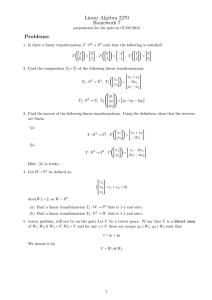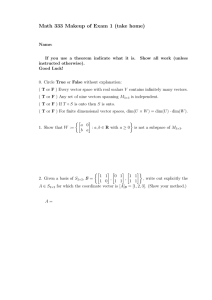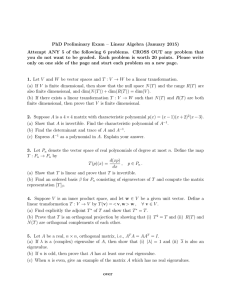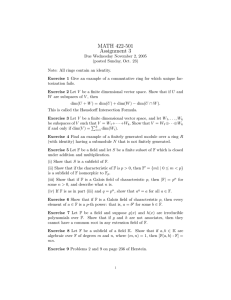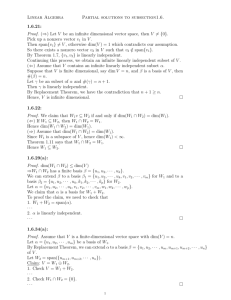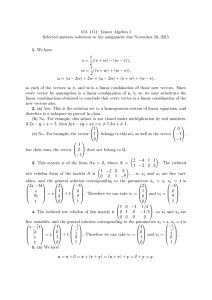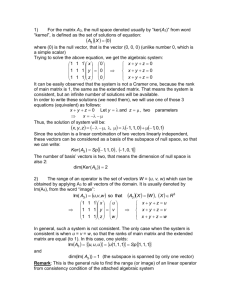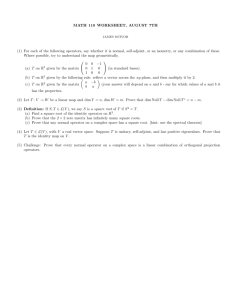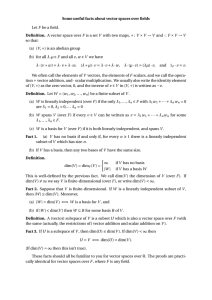EXAM I – Linear Algebra I Part I – In Class
advertisement
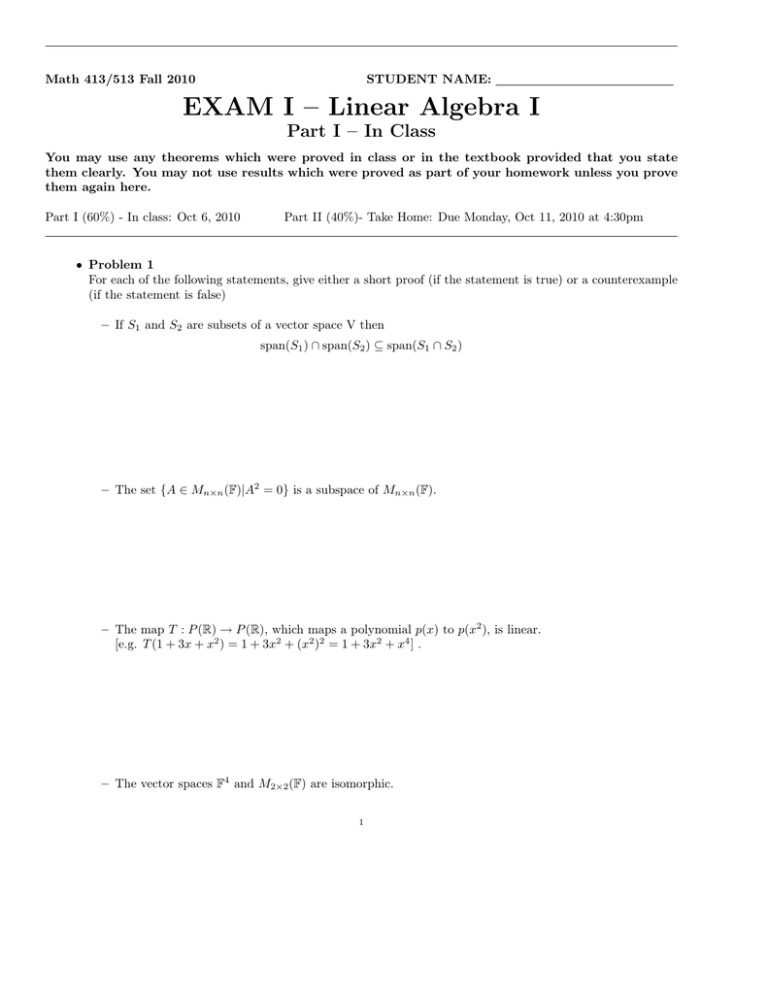
Math 413/513 Fall 2010
STUDENT NAME:
EXAM I – Linear Algebra I
Part I – In Class
You may use any theorems which were proved in class or in the textbook provided that you state
them clearly. You may not use results which were proved as part of your homework unless you prove
them again here.
Part I (60%) - In class: Oct 6, 2010
Part II (40%)- Take Home: Due Monday, Oct 11, 2010 at 4:30pm
• Problem 1
For each of the following statements, give either a short proof (if the statement is true) or a counterexample
(if the statement is false)
– If S1 and S2 are subsets of a vector space V then
span(S1 ) ∩ span(S2 ) ⊆ span(S1 ∩ S2 )
– The set {A ∈ Mn×n (F)|A2 = 0} is a subspace of Mn×n (F).
– The map T : P (R) → P (R), which maps a polynomial p(x) to p(x2 ), is linear.
[e.g. T (1 + 3x + x2 ) = 1 + 3x2 + (x2 )2 = 1 + 3x2 + x4 ] .
– The vector spaces F4 and M2×2 (F) are isomorphic.
1
• Problem 2 Find a basis for the following subspace of R5 :
W = {(a1 , a2 , a3 , a4 , a5 ) ∈ R5 : a1 = a3 = a4 and a2 + a5 = 0}.
What is the dimension of W ?
• Problem 3
Rx
Consider the map T : P2 (R) → P3 (R) given by T (f )(x) = 0 f (t) dt.
Let β = {1, x, x2 } and γ = {1, x, x2 , x3 } be the standard ordered bases for P2 (R) and P3 (R).
(a) Compute [T ]γβ
(b) What is the rank of T ?
• Problem 3
Let T : V → W be a linear transformation between two vector spaces V and W .
(Math 413 students may assume V and W are finite dimensional, whereas Math 513 students need to proceed
without this assumption)
(a) Show that if G is a generating set for V , then T (G) is generating set for R(T ).
(b) Show that if L is a linearly independent set in R(T ), then there exist a linearly independent set L̃ in V
such that T (L̃) = L.
(c) Show that T is invertible if and only if, for every basis β in V , T (β) is basis in W .
• Problem 4
Let T : R2 → R2 be defined by
T
a
3a − b
=
.
b
a+b
1
2
Find [T ]β , the matrix representation of T in the nonstandard basis β = {
,
}.
1
0
• Problem 5
Let A be an m × n matrix with rank m. Prove than there exists an n × m matrix B such that AB = Im .
Does it imply that BA = In ? Explain.
[Hint: Consider the left multiplication transformation T = LA ].
Math 413/513 FALL 2010
STUDENT NAME:
EXAM I – Linear Algebra I
Part II – Take Home
DUE Wed, Oct 13 at 4:30pm
You may use any theorems which were proved in class or in the textbook provided that you state
them clearly. You may not use results which were proved as part of your homework unless you prove
them again here.
ABSOLUTELY NO TEAM WORK ALLOWED!!!
Math 513 students are required to answer all questions!
The starred (*) problems are optional (extra-credit) for Math 413 students.
• Problem 1
Let V be a finite dimensional vector space over a field F with dim(V ) = n.
(a) Show that the space of all linear transformations from V to V , L(V ) = {T : V → V | T is linear}, is
isomorphic to Mn×n (F). [Hint: Use the matrix representation [T ]β with respect to some fixed basis β.]
(b) What is the dimension of L(V )?
(c) Given T ∈ L(V ), define the trace of T to be trace([T ]β ), for some basis β for V . Show that this quantity is
independent of the basis β, that is trace([T ]β ) = trace([T ]β 0 ) for any two bases β and β 0 for V . [See exercise
10 page 118 and exercise 13 page 97]
• Problem 2
(a) Let α, β1 , β2 be three ordered bases for a vector space V . Denote Q1 and Q2 the change of basis matrix
from α to β1 and from α to β2 , respectively. Show that the change of basis from β1 to β2 is then given by
the matrix Q = Q−1
1 Q2 .
1
1
0
(b) Using part (a), find the change of basis matrix from the basis β1 = {1 , 0 , 1} to the basis
0
1
1
2
0
1
β2 = {1 , −1 , 3 } of R3 .
3
1
−2
1
1
(c) Consider the linear transformation T : R3 → R3 given as the projection on W1 = span{1 , 0}
0
1
0
a
along W2 = span{1} (see definition on page 76). Determine T b and verify that T 2 = T .
1
c
• Problem 3*
Let V be a vector space (not necessarily finite dimensional) and T, U : V → V be linear transformations.
(a) Show that dim(N (U T )) ≤ dim(N (U )) + dim(N (T )).
(b) Show that dim(R(U T )) ≤ min{dim(R(U )), dim(R(T ))}.
When does equality occur in (a) and in (b)? (See Lemma 2 page 135 for (a))
[Do not assume V is finite dimensional! Consider all cases when the dimensions in questions are finite or
infinite. Inequalities such as ∞ ≤ ∞ + ∞ etc are considered true.]
(c) For a given T : V → V , consider the map ΦT : L(V ) → L(V ) given by ΦT (U ) = U T . (See problem 1
for notation). Show that ΦT is a linear transformation and describe its null space N (ΦT ) and range R(ΦT ).
Compute its nullity and rank.
1 2
2
[Hint: you may try first some simple example, e.g. V = R and T = LA with A =
]
2 4
(d) Is there any difference if one considers instead at ΨT : L(V ) → L(V ) given by ΨT (U ) = T U ?
